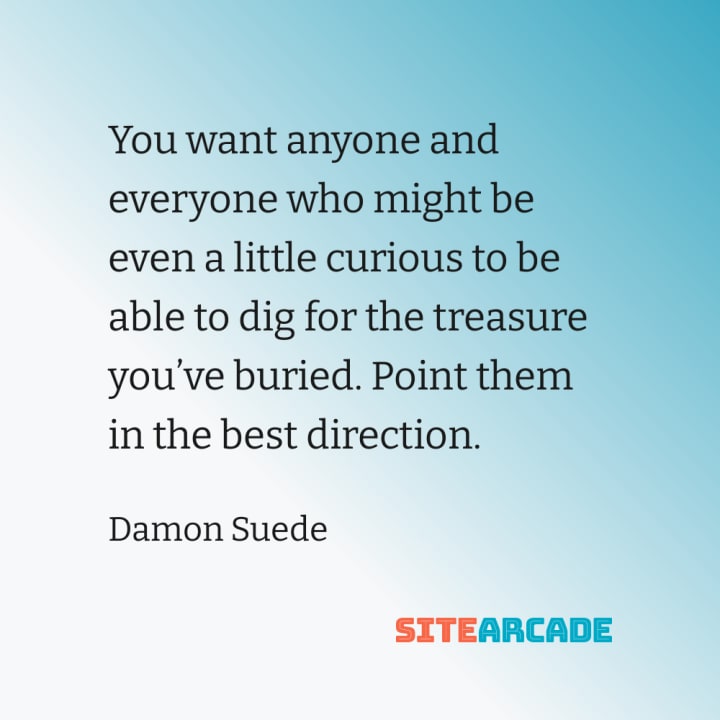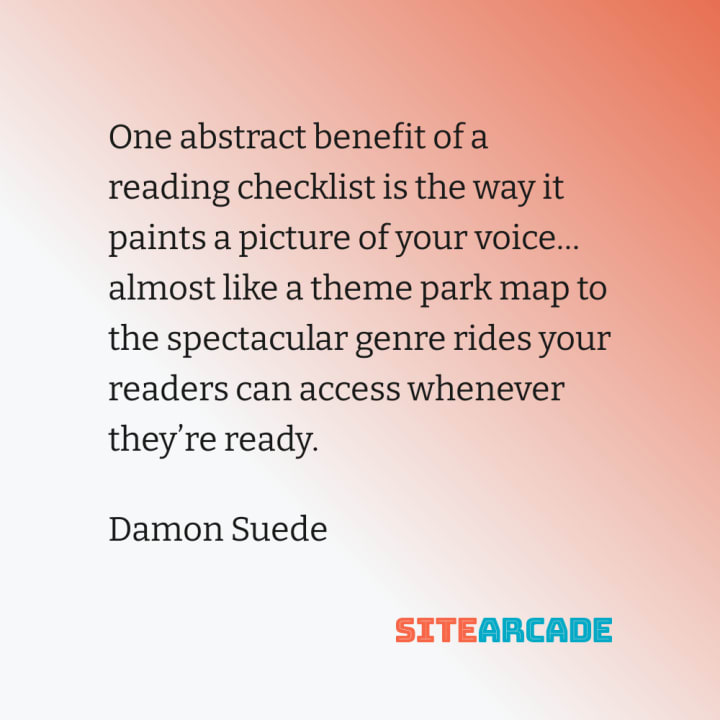Building a Reading Order Guide to Expand Your Fandom
Want to build a free promotional resource useful to readers, colleagues and industry pros? Consider compiling and offering a reading order checklist for your work.
Whether you’ve written five books or fifty, anything you can do to map your published projects helps readers find a user-friendly entry point and a way to share your writing. One of the simple resources to offer your audience is a quick reference-at-a-glance that encapsulates your collected body of work and charts a clear course for the innocent, the eager, the distracted, and the distractable.
Obviously readers show up with different tastes and expectations, but long after you’ve stopped promoting a title, a comprehensive list will help folks navigate your output. Binge-reading deserves encouragement, and whatever you can do to support passionate completists do a deep-dive into your voice is a blessing devoutly to be wished. Never underestimate the power of a quick handle on the whole picture.
The first time I saw these kinds of reading order guides I was dubious, until I spotted random “helpful” strangers selling guides to popular authors/
What to Include in Your Readers Checklist
Ask yourself: What are the basic recurrent questions the average browser might ask? What kinds of confusion derails new readers and vendors perennially? What details and identifiers would help anyone navigate everything you’ve written in the genre? At core, you want to list of your entire body of work in the order you think readers will enjoy it most, a general overview of your published titles that includes:
- Title/
Year/ ISBN: Give people the basic details to facilitate searches, natch. - Cover art: Humans are visual, and you want everyone to be able to spot your titles instantly. That cover can do heavy lifting.
- Genre/
subgenre: Make certain that the categories are accurate and specific, because a cheated reader will work actively to steer folks away from your books. - One-click buy links: …And I don’t just mean Amazon! Give people options to shop with their go-to vendors via handy hyperlinks (with your affiliate code embedded, natch).
- Reading order details: Definitely let browsers know if later books include spoilers for earlier releases. Connect titles clearly to prequels and sequels. If any a book’s characters spin off into a new series, that can be helpful info as well.
- Versions: Don’t forget to flag audiobooks, translations, boxsets, and rereleases so readers can find your work however they prefer.
If you want to go a little deeper, you can help curious browsers more by providing:
- Length: Some readers shop by page count, so show them the scope of the landscape.
- Tropes: Offer a short list of the popular hooks and fan candy featured in a title.
- Central names: Foreground your protagonists and antagonists. Especially for romance, you should let folks know what lovers take center stage in each title to help them situate this title in the series arc.
- A brief logline: Don’t overwhelm them with data, but if you have under 20 titles to your name, a snappy 10–20 word summary of each book (or series) might hook a casual browser’s attention.
In this instance, you don’t want to include a full blurb. If any casual browser wants to do a deeper dive, they can find that elsewhere on your site, but the purpose of this specific document is a quick reference easily accessed and navigated. You want to bait the hook, not serve them a full fish dinner.
Keep this checklist simple. On your website, you can always include ample links to additional info and explanations as part of this brief reference so people can fall down the relevant rabbit holes should they wish. But you don’t want to overwhelm or distract them from the coherent overview; it should be as browse-able as possible. The primary goal is intriguing clarity.
Where to Place Your Reading Guide
Where does this critter go? On your website (obviously), in your online presskit and your overall “Books” or “Works” page. You should include a brief link to the checklist in your newsletter in case someone has a question and isn’t sure where to find answers. If you want to get super-slick, consider formatting the list as a printable PDF one-sheet that could be shared by a librarian or bookstore.
Essentially, you want anyone and everyone who might be even a little curious to be able to dig for the treasure you’ve buried. Point them in the best direction.

Also consider including it as back matter in your published titles, especially if you self-pub or work with a smaller publisher willing to reference titles they don’t print. If you do include it as backmatter inside a book, don’t remove that book’s title from the list; what readers need is coherent picture of the worlds you’ve built.
Every time you have a new release, update this checklist to keep it current and prevent any series titles from getting lost in the output tangle. Once it’s built, you can maintain it with a few minutes of effort after each new title emerges. With the reading checklist on deck and updated regularly, you can easily point any curious souls in a helpful direction and so can your fans and colleagues. Help them help you!
Benefits of Reading Order Checklists
This kind of E-Z reference is useful for librarians, vendors, editors, book clubs, and anyone who needs to seem like an instant encyclopedic expert on your body of work. Reading checklists are also catnip for otaku completists in the fandom. Many hardcore readers insist on starting a series (or even an author’s entire body of work) at the beginning, so having an official guide, anchored in the canon, guarantees that they’re diving in where they should and swimming in the right direction.
In practice, this checklist often does double promo-duty, because bloggers and journalists on deadline often need a quick reference that provides character names, ISBNs, and a quickie overview of your output they can access on the fly at odd hours.
One abstract benefit of a reading checklist is the way it paints a picture of your voice… almost like a theme park map to the spectacular genre rides your readers can access whenever they’re ready. You can even give it a brief (hyperlinked) mention when launching new titles to help readers wanting to explore your work further. It shows them at a glance all the places you have the power to take them if they’re willing.

And you may think I’m bananas, but I also find that I use my own checklist more often than I’d care to admit. Yes, really. When I’m answering obscure questions during a panel or need to verify a detail while sitting on an outbound airplane, an accurate, accessible reference to my own work is a lifesaver. So yes indeed, I wind up tapping my own reading resource more than I’d care to admit to make sure I don’t look like an addled nitwit about my own career in public.
These days, book promo can turn expensive, complicated, and stressful. A reading checklist is literally none of those things; even the most anxious luddite can create one with little effort and a willing, enthusiastic professional will manage much more than that. Invest an hour or two building a reusable resource for curious readers, and you may end up with die-hard, deep-dive fans for life.